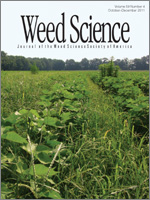Field and pot studies were conducted in Central New York to determine the potential weed-management benefits of a buckwheat cover crop grown before winter wheat. Specific objectives were to determine buckwheat residue effects on (1) emergence and growth of winter annual weeds; (2) wheat establishment and yield; and (3) emergence of summer annual weeds in the spring following overwinter seed burial. In a field study, buckwheat was sown at two timings (July or August), mowed, and either incorporated or left on the soil surface. Winter wheat was drilled into buckwheat residue in September and weed and crop growth were monitored. In a complementary pot study, four winter annual weeds were sown in soil removed from buckwheat and bare-soil plots at 0 or 15 d after incorporation and monitored for emergence and early growth. To assess buckwheat residue effects on spring emergence from overwintering seeds, seeds of three weed species were buried in buckwheat residue and bare-soil plots in the fall, exhumed in April, and evaluated for emergence. To investigate the mechanism for possible effects of buckwheat residue on overwintering seeds, two levels each of seed treatment (none or fungicide) and fertilization (none or 170 kg ha−1) were applied before burial. Buckwheat residue had no negative effect on wheat yields but suppressed emergence (22 to 72%) and growth (0 to 95%) of winter annual weeds, although effects were often small and inconsistent. Buckwheat residue had no effect on the emergence of buried weed seeds in spring. However, fungicide treatment enhanced the emergence of Powell amaranth seeds by 12.5 to 25.5% and of barnyardgrass seeds by 0 to 12%. Our results suggest that buckwheat residue can contribute to weed management in wheat cropping systems, but that further studies investigating the mechanistic basis for the inconsistent selective effects of buckwheat residue on weeds are needed before buckwheat use can be optimized.
Nomenclature: Powell amaranth = green pigweed, Amaranthus powellii S. Wats. AMAPO; hairy galinsoga, Galinsoga ciliata (Raf.) Blake GASCI; barnyardgrass, Echinochloa crus-galli (L.) Beauv. ECHCG; common chickweed, Stellaria media (L.) Vill. STEME; yellow rocket, Barbarea vulgaris Ait. f. BARVU; corn chamomile, Anthemis arvensis L. ANTAR; shepherd's-purse, Capsella bursa-pastoris (L.) Medik. CAPBP; winter wheat, Triticum aestivum L.; buckwheat, Fagopyrum esculentum Moench.





